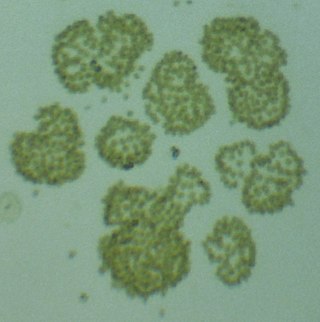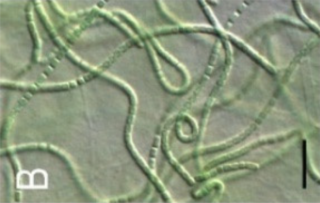
Oscillatoria is a genus of sugar making microscopic creatures.

Synechococcus is a unicellular cyanobacterium that is very widespread in the marine environment. Its size varies from 0.8 to 1.5 μm. The photosynthetic coccoid cells are preferentially found in well–lit surface waters where it can be very abundant. Many freshwater species of Synechococcus have also been described.
Oocystaceae is a family of green algae, in the order Chlorellales. The type genus is Oocystis.

Schroederia is a genus of green algae in the family Schroederiaceae. Schroederiaceae is a monotypic taxon; Schroederia is its only genus.

Scytonema is a genus of photosynthetic cyanobacteria that contains over 100 species. It grows in filaments that form dark mats. Many species are aquatic and are either free-floating or grow attached to a submerged substrate, while others species grow on terrestrial rocks, wood, soil, or plants. Scytonema is a nitrogen fixer, and can provide fixed nitrogen to the leaves of plants on which it is growing. Some species of Scytonema form a symbiotic relationship with fungi to produce a lichen.

Planktothrix is a diverse genus of filamentous cyanobacteria observed to amass in algal blooms in water ecosystems across the globe. Like all Oscillatoriales, Planktothrix species have no heterocysts and no akinetes. Planktothrix are unique because they have trichomes and contain gas vacuoles unlike typical planktonic organisms. Previously, some species of the taxon were grouped within the genus Oscillatoria, but recent work has defined Planktothrix as its own genus. A tremendous body of work on Planktothrix ecology and physiology has been done by Anthony E. Walsby, and the 55.6 kb microcystin synthetase gene which gives these organisms the ability to synthesize toxins has been sequenced. P. agardhii is an example of a type species of the genus. P. agardhii and P. rubescens are commonly observed in lakes of the Northern Hemisphere where they are known producers of potent hepatotoxins called microcystins.

Collodictyonidae is a group of aquatic, unicellular eukaryotic organisms with two to four terminal flagella. They feed by phagocytosis, ingesting other unicellular organisms like algae and bacteria. The most remarkable fact of this clade is its uncertain position in the tree of life.

The Pseudanabaenaceae are a family of cyanobacteria.
Trichodesmium thiebautii is a cyanobacteria that is often found in open oceans of tropical and subtropical regions and is known to be a contributor to large oceanic surface blooms. This microbial species is a diazotroph, meaning it fixes nitrogen gas (N2), but it does so without the use of heterocysts. T. thiebautii is able to simultaneously perform oxygenic photosynthesis. T. thiebautii was discovered in 1892 by M.A. Gomont. T. thiebautii are important for nutrient cycling in marine habitats because of their ability to fix N2, a limiting nutrient in ocean ecosystems.

Woronichinia is a genus of cyanobacteria, belonging to the family Coelosphaeriaceae.
Anathece is a genus of cyanobacteria belonging to the family Synechococcaceae.
Eucapsis is a genus of cyanobacteria belonging to the family Merismopediaceae.
Geitlerinema is a genus of cyanobacteria belonging to the family Coleofasciculaceae.

Aphanothece is a polyphyletic genus with 63 accepted species. The name is derived from the Greek words, ‘aphanes’ and ‘theke’ which mean “invisible" and “box or sheath” respectively. This genera is cosmopolitan, found in soils, thermal springs and other benthic, freshwater, marine, hypersaline, and moist terrestrial environments. Morphology can vary, with both microscopic and macroscopic colonies large enough to be collected and preserved in herbarium records.

Chamaesiphon is a genus of cyanobacteria belonging to the family Chamaesiphonaceae.
Heteroleibleinia is a genus of algae belonging to the family Pseudanabaenaceae.
Jaaginema is a genus of cyanobacteria belonging to the family Pseudanabaenaceae.

Leptolyngbya is a genus of cyanobacteria belonging to the family Leptolyngbyaceae.
Limnococcus is a genus of cyanobacteria belonging to the family Chroococcaceae.
Phormidium aerugineo-caeruleum is a species of cyanobacteria in the genus Phormidium.











